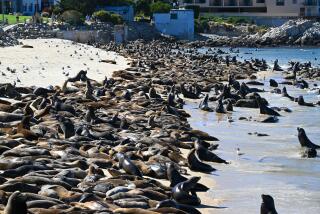Sea Otter Resettlement Enters New Phase
- Share via
VENTURA — Despite a dismal first year trying to establish a new sea otter colony on one of the Channel Islands, the U.S. Fish and Wildlife Service on Tuesday began the second phase of its controversial plan to relocate 250 of the furry animals from the central coast by 1992.
Using fishing nets and scuba gear, biologists set out again to capture as many as 70 of the 1,700 otters living from Pismo Beach to Santa Cruz and airlift them to San Nicolas Island, an isolated speck southwest of Los Angeles.
Although commercial fishermen have complained that the relocation will decimate the area’s shellfish, which the otters feed on, federal officials say the $1-million-a-year program is necessary to protect the otters, whose existing coastal colony could be wiped out by an oil spill or disease.
The otters, however, have yet to flourish at their new home 70 miles offshore. Of the 69 animals brought last year to San Nicolas, only 14 remain. Ten have died. Thirteen swam back to the mainland. One errant otter was returned to the mainland by the wildlife service. And 31 are missing and unaccounted for.
The deaths, which have raised doubts even among biologists involved in the relocation, have been the result of stress related to capture, drowning in fishing gear and a gunshot wound to one otter, which was found wrapped in chains last fall near Point Mugu.
“I felt and still feel it’s the right thing to do,” said Jim Estes, a U.S. Fish and Wildlife research biologist in Santa Cruz. “But the question of whether or not this thing is going to be successful still has not been answered.”
To brand the program a failure, however, would be a mistake, Estes said, adding that such relocations are always tricky operations and that it can take years to establish a thriving new community.
In Washington state, for instance, biologists relocated 59 otters between 1969 and 1970, only to find that just 19 remained in 1977. The downward trend did not halt until the early 1980s when the otter population grew to 36, and could not be deemed a success until 1987 when the number hit 94.
But the program’s critics, including the fish and game commissions of Santa Barbara and Ventura counties, say the first-year results are indicative.
“If they keep this up, the California sea otter truly will become an endangered species,” said Jim Donlan, chairman of the Ventura County commission, which has jurisdiction over the island. “It’s a disaster.”
Despite the local opposition, the California Fish and Game Commission has given the program its blessing, as has the California Coastal Commission and various environmental groups.
The California sea otter, which once numbered nearly 20,000, was forced to the brink of extinction in the 19th Century by hunters. By 1911, when sea otter hunting finally was banned, fewer than 100 of the animals remained.
Slowly, though, at a rate of about 5% a year, the herd made a remarkable recovery, reaching its present count of about 1,700 in 1976. However, the growth suddenly stopped, and it was not long before federal officials listed the otter, known to scientists as Enhydra lutris nereis, as a threatened population under the Endangered Species Act.
Although at least 100,000 now live in the Aleutian Islands of Alaska, biologists still consider the California herd in jeopardy because of the tankers hauling more than 100 million barrels of oil each year along the state’s coast.
As a kind of insurance policy against a devastating calamity, the wildlife service proposed establishing a second colony at Navy-owned San Nicolas, which was once home to the animals and boasts a hearty supply of otter food--abalone, sea urchins and spiny lobsters.
More to Read
Sign up for Essential California
The most important California stories and recommendations in your inbox every morning.
You may occasionally receive promotional content from the Los Angeles Times.










